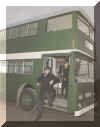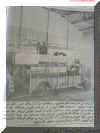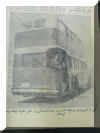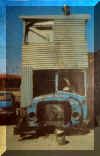Iran
From
1958 to 1972 some nine-hundred buses were built for Tehran (Iran); the first
batches up to 12/1967 were 250 AEC Regent V and the last batches from 1972 to
1974/5 comprised 650 Leyland Atlanteans; making the Shah of Persia PRV's most
important overseas buyer.
 Here is the Shah (Mohammad Reza
Pahlavi [1919-1980]) -
stepping out of one of his new Atlanteans circa 1972 (he is on the platform
holding on to the vertical pole). I don't know where this was pictured -
it seems it might be an airfield - nor do I know who the man stepping vigorously
off the platform is; anyone know?
Here is the Shah (Mohammad Reza
Pahlavi [1919-1980]) -
stepping out of one of his new Atlanteans circa 1972 (he is on the platform
holding on to the vertical pole). I don't know where this was pictured -
it seems it might be an airfield - nor do I know who the man stepping vigorously
off the platform is; anyone know?
This
image is a bit of a cheat as I think this is pictured at an airfield in the UK;
so here's a challenge - can anyone supply images of PRV bodied buses in
Tehran? There are no prizes just the kudos; my thanks in anticipation, Ed.
https://en.wikipedia.org/wiki/Mohammad_Reza_Pahlavi
(Image from the Don Matthews collection)
 [a] Here is the Shah again; an earlier image to the above as this time he is
pictured, no doubt in Tehran, inspecting one of the first of the AEC Regents
that were delivered from 1958.
[a] Here is the Shah again; an earlier image to the above as this time he is
pictured, no doubt in Tehran, inspecting one of the first of the AEC Regents
that were delivered from 1958.
Close inspection of the front of the bus shows a plate with the
words 'PARK ROYAL' prominently displayed.
I have never seen this before as the name of the coachbuilder was never
displayed there.
(Image
supplied by Borzou Sepasi)

 [b] And here is one of those AEC Regent V buses, pictured somewhat later, in operation in Tehran.
The enlarged image shows an advertising plaque sited just to the left of the entrance
door (something else I haven't seen before). It reads "made by AEC of England, the producer of double deck buses for the big cities of the world".
This, message, of course, was an exaggeration.
[b] And here is one of those AEC Regent V buses, pictured somewhat later, in operation in Tehran.
The enlarged image shows an advertising plaque sited just to the left of the entrance
door (something else I haven't seen before). It reads "made by AEC of England, the producer of double deck buses for the big cities of the world".
This, message, of course, was an exaggeration.
(Images & translation supplied by Borzou Sepasi)
Note:
This might seem insignificant, but the two images above marked [a] &
[b] tell a story:
In image [a] is
something I've never seen before; the front of the bus is emblazoned with the
words 'PARK ROYAL' and it's even more prominent
than the AEC badge. And, as it has always been the chassis manufacturer that took all
the credit with the coachbuilders' rarely considered worthy of mention, this
feature is somewhat surprising.
AEC
would never have agreed to placing the coachbuilders' (PRV 'Park Royal') sign
there as this would have defied British commercial transport industry
convention; that of course suited AEC, and other chassis builders' narratives. Perhaps Park
Royal might have placed the sign on the bus itself, but AEC would have
considered this act presumptuous and would have been very annoyed.
So maybe The Shah requested it? And who would argue with The Shah?
But
Borzou Sepasi has another theory; he believes
that the
management of the "Vahed Transport Company of Tehran" had
requested that the name 'PARK ROYAL' be prominently placed on the front of the
bus. Why?
Vahed needed to name its new British bus in a way that would be very familiar to
its travelling public. The name 'AEC' or 'Associated Equipment Company' has no
obvious equivalent in Farsi (the language of Iran) and are difficult to
pronounce. However the English words PARK & ROYAL, were already
'borrowed' words (aka 'loanwords') in the Farsi language and when spoken in
Farsi are pronounced exactly as in English, so no Farsi speaker would have any
problem calling the new bus a 'PARK ROYAL'.
Borzou's
suggestion is perfectly reasonable, even though it utterly opposed the UK Bus Industry's long-time unstated agreement on hierarchy, and this
too is surprising. However, even AEC would have agreed to it for the largest ever order of Regents at the
time. Thus AEC, for once, had to take a subjugated role and let PRV have the 'unintended'
glory of it's name on the front of the bus; and that must have been irksome for AEC
management.
In
my opinion AEC's vexation was demonstrated by the advertising plate on the side of those
Regents; image [b].
If AEC had to accept 'PARK ROYAL' on the front of the bus then it was going to
advertise itself by the entrance door. And I've never seen that before either.
I think, from this, it can be appreciated how the archaic working relationship between the sibling companies AEC & PRV,
where, from middle management down, each considering itself superior (especially
AEC) to the other, didn't help their joint businesses. In my opinion this
unnecessary rivalry had harbingered during and since the Routemaster project,
and perhaps ACV should have done more to smooth the
relationship.
These seemingly small issues do help to tell the real story about these companies and not the one often told, even today, in commercial vehicle history publications. And, by the way, the Routemaster is still called the AEC Routemaster even though PRV
built it.
(Please
click here for my article 'Let's hear it for the Coachbuilders')
End Note
0----------0----------0----------0----------0----------0----------0----------0----------0
An
AEC Regent filmed, in service, in Tehran, Iran circa 1969. Courtesy Borzou
Sepasi
Please Note: This video is 31 seconds long, but is shown three times; otherwise YouTube considers it a
'short' mobile video; it then changes its format and disallows its display when embedded within
Windows (as it is here).
(You
can find this and other videos here)
0----------0----------0----------0----------0----------0----------0----------0----------0
 And here is one of the 650 Leyland Atlanteans built for Tehran.
Photographed recently (October 2023) it's PRV bodywork does,
admittedly, look somewhat shabby now; but, to be fair, it is well into it's 6th
decade on the road. Though I don't think it's providing commercial
passenger services nowadays, it clearly provides ample shade for those needing a
quiet repose!
And here is one of the 650 Leyland Atlanteans built for Tehran.
Photographed recently (October 2023) it's PRV bodywork does,
admittedly, look somewhat shabby now; but, to be fair, it is well into it's 6th
decade on the road. Though I don't think it's providing commercial
passenger services nowadays, it clearly provides ample shade for those needing a
quiet repose!
(Image
supplied by Borzou Sepasi)
 Borzou Sepasi who has sent in this extraordinary image that appeared in a 1985
Iranian film entitled 'The other side of the fog'. In the background is
shown a PRV bodied AEC Regent V repurposed as a truck. What's left of the
bus is limited to the front end and door arrangement changed to a cab.
This makes for a strikingly good utility vehicle on a very strong chassis.
It's appearance is so 'fit-for-purpose' it might easily have been designed as a
truck initially.
Borzou Sepasi who has sent in this extraordinary image that appeared in a 1985
Iranian film entitled 'The other side of the fog'. In the background is
shown a PRV bodied AEC Regent V repurposed as a truck. What's left of the
bus is limited to the front end and door arrangement changed to a cab.
This makes for a strikingly good utility vehicle on a very strong chassis.
It's appearance is so 'fit-for-purpose' it might easily have been designed as a
truck initially.
(see the LHD PRV/AEC Regent V under
construction for Tehran)
(Image
supplied by Borzou Sepasi)

 And also, from Borzou, are these
very interesting old newspaper images from Tehran:
And also, from Borzou, are these
very interesting old newspaper images from Tehran:
The first is of a Regent V body being 'reconstructed' by the local 'Vahed Bus
Company' in Tehran, from a 'flat-pack' supplied by Park Royal. This was, perhaps
surprisingly, an approach to order fulfilment that PRV offered where there was a
local
workforce capable of understanding and carrying out bus body construction with
support from Park Royal.
(Image
supplied by Borzou Sepasi)
It's known from this 1951 Export Brochure
that Park Royal had a very
successful export business, of which 'local builds' often formed a significant
part; especially as there were considerable savings in transportation charges in
comparison with those associated with shipping fully built vehicles.
Though I believe the 1951 'Export Brochure' was the only one ever produced since no others were
in my father's collection and none have turned up since Leyland closed Park
Royal in 1980.
Here shown
in the 1951 Export Brochure are some 'flat packs' being assembled ready
for shipping.
(This is the only image I have seen of local construction; Ed.)
The second image shows an improvement in local safety by
the 'Vahed Bus
Company' in Tehran; its this worthwhile, and some may conclude an essential, addition of a platform
restraining panel.
Open platform buses (e.g. Routemasters')
especially in London, were, and remain, a risk, due to their hop-on/hop-off
nature; nonetheless Londoners' remained enthusiastic about them for that very
reason and in the traffic-clogged city alighting (with extreme care) midway
between official stops could be very convenient.
(I have never seen a platform restraining panel like this and what a good
idea it was; Ed.)
(Images
supplied by Borzou Sepasi)
 This
image supplied by Borzou is a bit of a mystery. From the "Kayhan"
newspaper published in October 1957, it describes an AEC bus, said to have been
imported by the Galoostian Company, being shown at the British Embassy in Tehran; apparently
in the presence of the Iranian Prime Minister and the British
Ambassador. Whilst it is said to be an AEC chassis, there is no
indication of the marque (I am guessing a Regal III or IV), and neither is the
coachbuilder named. I can not find any evidence of a Regal being built by
Park Royal for Iran in late 1957 though several Regal IIIs were built for Iraq
in the September of that year and it's quite possible one might have been
redirected (by Galoostian?) to the British Embassy in Tehran for the purpose of
a private showing.
This
image supplied by Borzou is a bit of a mystery. From the "Kayhan"
newspaper published in October 1957, it describes an AEC bus, said to have been
imported by the Galoostian Company, being shown at the British Embassy in Tehran; apparently
in the presence of the Iranian Prime Minister and the British
Ambassador. Whilst it is said to be an AEC chassis, there is no
indication of the marque (I am guessing a Regal III or IV), and neither is the
coachbuilder named. I can not find any evidence of a Regal being built by
Park Royal for Iran in late 1957 though several Regal IIIs were built for Iraq
in the September of that year and it's quite possible one might have been
redirected (by Galoostian?) to the British Embassy in Tehran for the purpose of
a private showing.
(Can anyone confirm anything about this bus? Ed.)
 This
image of an advertisement for the AEC Regal was kindly sent in by Borzou Sepasi,
who believes it dates from around 1944/5. It is written in Persian (Farsi) and
Borzou has also kindly provided the translation as follows:
This
image of an advertisement for the AEC Regal was kindly sent in by Borzou Sepasi,
who believes it dates from around 1944/5. It is written in Persian (Farsi) and
Borzou has also kindly provided the translation as follows:
A.E.C Regal
The Carpet of Prophet Solomon in today's world.
The features of this car are as follows:
1. It is made of the finest materials and has great durability.
2. It is equipped with a fuel-efficient six-cylinder diesel engine.
3. It is designed to handle tough tasks with ease.
4. Its soft suspension makes the ride very comfortable.
5. This bus is designed solely for passenger transport.
For more information, please visit A. E. Co Ltd. Southall, Middlesex, London
The manufacturers of London buses.
The Associated Equipment Co. Ltd.,
Southall, Middlesex, England.
AEC clearly hoped this 'clever' artists impression,
depicting a Regal chassied coach on a 'Flying Carpet', would create many orders
destined for the Iranian capital Tehran; though not in right-hand-drive I
suspect. (Can anyone confirm anything about this
intended vehicle? Ed.)
 This image of the wreck of one of those first 1958 AEC Regent's delivered to Tehran is not all it may seem. Borzou Sepasi, who supplied the image, tells the story (Ed.):
This image of the wreck of one of those first 1958 AEC Regent's delivered to Tehran is not all it may seem. Borzou Sepasi, who supplied the image, tells the story (Ed.):
The image is part of a magazine cover from the early days of the 1979 revolution.
At that time, the newly established government was trying to strongly highlight the shortcomings of the previous regime.
Images and articles, like this one, were published in large numbers across various publications, often with a political motivation.
The intended message of this image was to depict homelessness during the Shah’s
rule.
However,
the reality behind the image is quite different from that which the article portrays.
The bus was stationed in an area where many of Tehran's homeless lived and was repurposed by a philanthropic doctor as a mobile clinic to serve the poor. The services provided were completely free and the
old bus managed to help many people in need.
Borzou Sepasi"
 Here is the Shah (Mohammad Reza
Pahlavi [1919-1980]) -
stepping out of one of his new Atlanteans circa 1972 (he is on the platform
holding on to the vertical pole). I don't know where this was pictured -
it seems it might be an airfield - nor do I know who the man stepping vigorously
off the platform is; anyone know?
Here is the Shah (Mohammad Reza
Pahlavi [1919-1980]) -
stepping out of one of his new Atlanteans circa 1972 (he is on the platform
holding on to the vertical pole). I don't know where this was pictured -
it seems it might be an airfield - nor do I know who the man stepping vigorously
off the platform is; anyone know?







